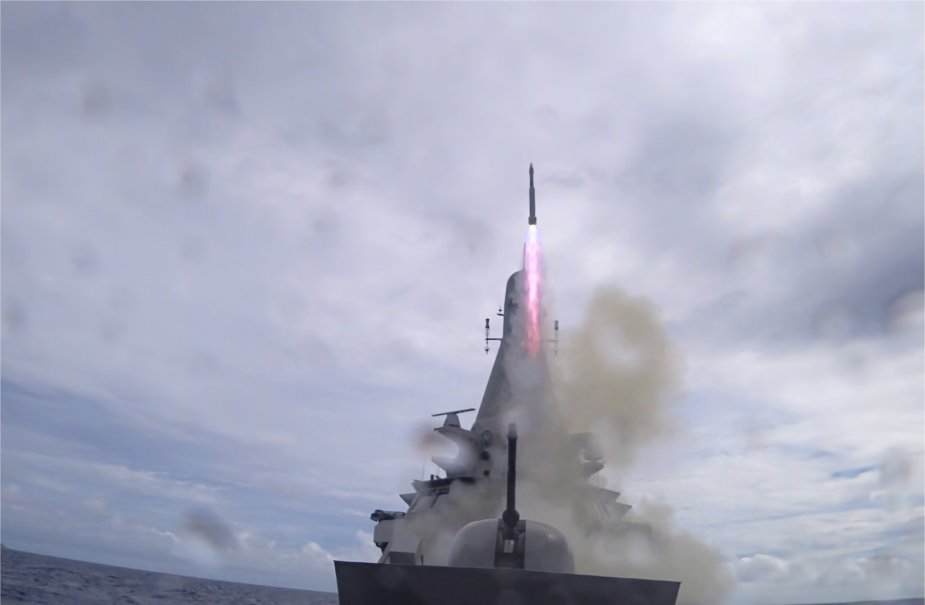Breaking news
Singapore Navy's LMV RSS Dauntless fires MICA missile for 1st time during drills with US.
According to information published by the Singapore MINDEF on June 30, 2023, the fourth bilateral Exercise Pacific Griffin between the Republic of Singapore Navy (RSN) and the United States Navy (USN) was successfully concluded in the waters around Guam.
Follow Navy Recognition on Google News at this link
 Independence-class littoral mission vessel RSS Dauntless firing MICA anti-air missile. (Picture source: Singapore MINDEF)
Independence-class littoral mission vessel RSS Dauntless firing MICA anti-air missile. (Picture source: Singapore MINDEF)
Singapore's naval participation included the Formidable-class frigate RSS Tenacious, equipped with an embarked S-70B Seahawk naval helicopter, and the Independence-class littoral mission vessel RSS Dauntless.
The USN represented themselves with the Ticonderoga-class guided-missile cruiser USS Shiloh, which hosted an embarked MH60R Seahawk naval helicopter.
They also included the Independence-class littoral combat ship USS Manchester, with an MH60S Seahawk and an MQ-8C naval helicopter, and the Lewis and Clark-class dry cargo ship USNS Cesar Chavez. The event also saw the involvement of naval divers from both the RSN and USN.
The exercise tested both navies in advanced naval warfare drills such as escorting high-value assets, naval gunnery firing, and a surface action group exercise, where both navies' assets and personnel executed a series of warfare missions.
The RSS Tenacious launched an anti-surface Harpoon missile, and the RSS Dauntless conducted the inaugural firing of the MICA anti-air missile. RSN naval divers also underwent training in areas such as maritime explosive ordnance disposal and maritime counter-terrorism operations.
Commencing biennially since 2017, Exercise Pacific Griffin underscores the strong naval relations between Singapore and the US, reinforcing their bilateral defense relations.
About the MICA
It is primarily designed to be launched from various platforms, including aircraft such as the Dassault Rafale, Mirage 2000, Mirage F1, and Su-30MKI, as well as from ground batteries, surface vessels, and submarines.
The Mica missile has specific specifications that make it a highly capable weapon. It has a mass of 112 kilograms (247 pounds) and measures approximately 3.1 meters (10 feet) in length. With a diameter of 160 millimeters (6.3 inches), the missile is compact and streamlined for efficient flight.
The warhead of the Mica missile weighs around 12 kilograms (26 pounds). It can be detonated through either proximity or direct impact mechanisms, allowing for effective engagement of targets. The missile is propelled by a solid-propellant rocket motor, which provides the necessary thrust for its flight.
The Mica missile has impressive operational ranges depending on the launch method. When air-launched, it can reach distances ranging from 0.5 to 80 kilometers (0.31 to 49.71 miles) or up to 100 kilometers (62 miles).
In vertical launch scenarios, the missile can achieve altitudes of up to 20 kilometers (12 miles) and fly at speeds of up to Mach 4, making it a high-speed interceptor.
The guidance system of the Mica missile consists of both midcourse and terminal guidance. During the midcourse phase, the missile employs inertial guidance, which enables it to navigate towards the target based on pre-programmed data.
In the terminal phase, the Mica missile utilizes either the MICA-RF/EM variant with active radar homing or the MICA-IR variant with infrared homing, depending on the specific version used.




























